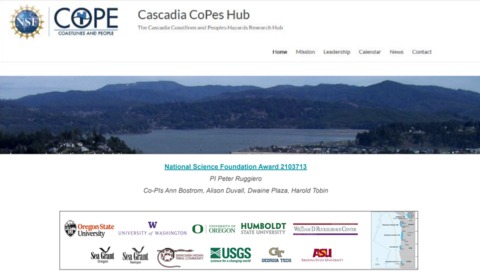Cascadia Coastal Hazards RCN Public Seminar Series
Thursday, October 07, 09:00 AM to 10:00 AM PDT
An Introduction to the Cascadia CoPes Research HUB
Presenters: Peter Ruggiero and Team Members
A virtual seminar of the Cascadia Coastal Hazards RCN, and co-sponsored by the CoPes HUB. The seminar is open to the public.
The Cascadia Coastlines and Peoples Hazards Research Hub
In response to the direct call by Pacific Northwest coastal communities for “a coordinated research agenda among universities, governmental agencies, NGOs, and others” to help them achieve resilience, the Cascadia Coastlines and Peoples Hazards Research Hub (Cascadia CoPes hub) will inform and enable integrated hazard assessment, mitigation, and adaptation—including comprehensive planning, policy making, and engineering—through targeted scientific advances in collaboration with communities. Pacific Northwest coastlines are at risk of great subduction earthquakes from the Cascadia subduction zone (CSZ), which extends more than 1000 km from Cape Mendocino in California through Oregon and Washington to Vancouver Island, Canada. Cascadia coastlines and peoples face acute shaking, subsidence, and tsunami inundation from a CSZ event, landslide and erosion risks aggravated by climate-driven intensifying atmospheric rivers, changing storminess patterns and sea level rise, as well as crustal faulting in the Salish Sea. Cascadia coastal communities also have rich and diverse cultural, social and governance histories, traditional and local ecological knowledge (TEK/LEK), and identities, values, and economies tied to their coastal locations and ecosystems. These distinguishing features position the Cascadia CoPes hub to transform understanding of the temporal pacing and interactions of acute and chronic coastal changes. The Cascadia CoPes hub will increase coastal community adaptive capacity, through community engagement and co-production, and by training a new generation of coastal hazards scientists and leaders from currently underrepresented communities in the region.
With inextricably linked tectonic and climate-driven coastal hazards, Cascadia provides a natural laboratory for the study of local coastal changes spanning time scales from minutes to millennia, reflecting complex and locally-specific layering of impacts from chronic and acute hazards. For example, long-term relative sea level rise (RSLR) is governed here by tectonic motion, with the highest west coast rates of RSLR found at the southern end of Cascadia, while RSLR is muted along some stretches of the Olympic Peninsula in the north by uplift. The Cascadia CoPes hub is designed to test two overarching hypotheses: (1) fundamental advances in convergent coastal hazard sciences will transform understanding of the risks coastal communities face and (2) an inclusive, co-produced approach to advancing hazard assessment and mitigation will increase coastal communities’ adaptive capacity and broaden participation in achieving equitable and just disaster risk reduction. With collaboratories representing the diversity of Cascadia coastlines and peoples, the project will: (a) identify likely sources of earthquakes, tsunamis, landslides, and land-level change, integrate new observations and develop coupled event simulations based on novel probabilistic tectonic multi-hazard risk models; (b) assess climate-driven compound fluvial-coastal flooding and how these drive coastal morphology changes and ecosystems, to quantify probabilistic exposure to coastal hazards under present and future conditions; (c) assess risk mitigation and dynamic adaptation strategies, including use of natural and nature-based features, (d) identify and test multi-use and asset-focused adaptation strategies for disaster risk reduction in processes that incorporate TEK/LEK, (e) study the inclusiveness of coastal governance structures for hazards resilience and science-informed hazards response, and (f) explore the conceptual linkages and communications challenges across (a-e).


